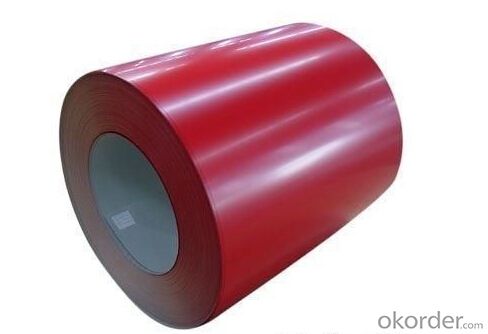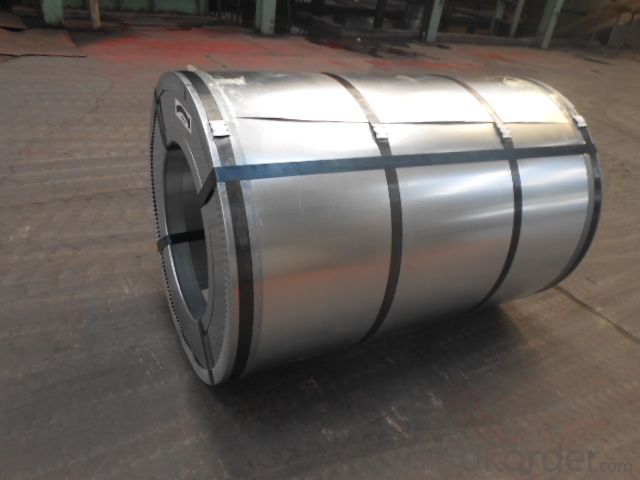Pre-Painted Galvanized/Aluzinc Steel Coil Color Blue
- Loading Port:
- Tianjin
- Payment Terms:
- TT OR LC
- Min Order Qty:
- 50 m.t.
- Supply Capability:
- 10000 m.t./month
OKorder Service Pledge
OKorder Financial Service
You Might Also Like
1. Pre-Painted Galvanized/Aluzinc Steel Coil Description:
With GI as base material, after pretreatment (degrease and chemical treatment ) and liquid dope with several layers of color, then after firing and cooling, finally the plate steel is called pre-painted galvanized (aluzinc) steel. Pre-painted galvanized steel is good capable of decoration, molding, corrosion resistance. It generally displays superior workability, durability and weather resistance.
2.Main Features of the Pre-Painted Galvanized/Aluzinc Steel Coil:
• Excellent process capability
• Smooth and flat surface
• Workability, durability
• Excellent heat resistance performance
• High strength
• Good formability
• Good visual effect
3.Pre-Painted Galvanized/Aluzinc Steel Coil Images


4.Pre-Painted Galvanized/Aluzinc Steel Coil Specification
Standard: AISI, ASTM, BS, DIN, GB, JIS
Grade: DX51D, DX52D
Thickness: 0.17-2.0mm
Brand Name: KMRLON
Model Number: coil
Type: Steel Coil
Technique: Cold Rolled
Surface Treatment: Coated
Application: Boiler Plate
Special Use: High-strength Steel Plate
Width: 20-1250mm
Length: customized
commoidty: pre-painted galvanized steel coil
Thickness: 0.13-4.0mm
width: 20-1250mm
zinc coating: 40-180g/m2
printing thickness: top side: 20+/-5 microns, back side: 5-7 microns
color: all RAL color
surface treatment: color coated
coil weight: 4-7 tons
coil ID: 508/610mm
packaging: standard seaworthy packing
5.FAQ of Pre-Painted Galvanized/Aluzinc Steel Coil
What’s the application of this product?
Roof, roof structure, surface sheet of balcony, frame of window, etc.
What’s the brand of the paint?
We use the best brand of all of the word—AKZO.
- Q:I want to know what to my wash stainless fridge door with before applying the stainless steel polish.
- if you first wash it with hot soapy water to get rid of any grease. Then make a solution of vinegar and water in a spray, spray the solution onto stainless steel, wipe down, then polish dry with a clean cloth, you will not need stainless steel polish as it will come up lovely and clean and shiny.
- Q:Why is steel a stiff material?I'm doing a project on the use of steel in the construction of skyscrapers - and obviously, for the inner steel skeleton of a skyscraper the steel support beams and girders will have to be stiff so that they don't fall apart or the building doesn't shake due to wind or other natural forces.But in my research I've found that steel (mild steel to be more exact) is ductile and malleable, meaning it can be shaped fairly easily. However, how can steel ALSO be stiff - the definition of stiffness is the tendency to withstand bending and stretching - so my question is. How can this material be BOTH ductile/malleable, AND stiff? and why? :)Thank you in advance if anyone takes the time to answer this, would be appreciated - I'll give you 10 points straight away if the answers conclusive
- To say that steel can be bent and shaped fairly easily isn't quite true. It takes multiple tons of force to do so, requiring some very heavy machinery. I think you're confusing a couple of concepts. For example the idea of elastic modulus, versus rigidity Rigidity is the ability of a structure to resist a load. That depends not only on the elastic modulus, but on the size and design of the structure or object. You can build fairly rigid structures out of wood. For example roller coasters. Even though wood has a much lower elastic modulus than steel, meaning that it takes much less force to bend and deform a given sample of wood.
- Q:What are the common methods of storing steel coils in warehouses?
- The common methods of storing steel coils in warehouses include stacking them on pallets or racks, using coil cradles or coil saddles to hold them in place, or utilizing specialized coil storage systems such as coil racks or coil cranes.
- Q:What are the common problems faced during steel coil production?
- Some common problems faced during steel coil production include surface defects such as scratches or dents, dimensional inconsistencies, coil breakage, edge wave formation, and coil slitting issues. Other challenges may include coil corrosion, improper coil cooling, and quality control issues.
- Q:What are the main factors that affect the strength of steel coils?
- The main factors that affect the strength of steel coils include the quality and composition of the steel used, the manufacturing process, the thickness and width of the coils, and any heat treatment or tempering applied to the steel. Additionally, factors such as storage conditions, handling, and transportation can also impact the strength of steel coils.
- Q:What are the different types of steel alloys used in coils?
- Coils commonly employ various types of steel alloys, each possessing unique properties and characteristics. Some frequently used types include: 1. Carbon Steel: As the most fundamental and widely utilized steel alloy in coils, it boasts low carbon content and renowned strength and durability. Carbon steel coils find extensive application in areas demanding high strength, such as automotive parts, construction materials, and machinery components. 2. Stainless Steel: Comprising an iron, chromium, and other element alloy, stainless steel coils exhibit exceptional resistance to corrosion, formidable strength, and heat resistance properties. They are typically employed in scenarios where shielding against corrosion and staining is pivotal, such as kitchen appliances, medical equipment, and transportation components. 3. Galvanized Steel: Galvanized steel coils are formed by coating regular carbon steel with a layer of zinc, furnishing excellent corrosion resistance and safeguarding the underlying steel from rust. Commonly utilized in outdoor settings like roofing, fencing, and automotive body parts. 4. Alloy Steel: Alloy steel coils are manufactured by incorporating diverse alloying elements like manganese, nickel, chromium, or molybdenum into carbon steel, thereby enhancing the steel's strength, hardness, and wear resistance. These coils frequently find application in industries necessitating high strength and toughness, such as machinery, tools, and construction equipment manufacturing. 5. Electrical Steel: Electrically specialized steel coils are designed explicitly for employment in electrical equipment like transformers and electric motors. These coils possess low electrical resistance and high magnetic permeability, facilitating efficient electricity conduction and magnetic field generation. Typically constructed from a silicon alloy, which enhances electrical and magnetic properties. In conclusion, the selection of a steel alloy for coils hinges upon the specific requirements of the given application, encompassing factors like strength, corrosion resistance, electrical conductivity, and heat resistance.
- Q:How are steel coils used in the construction of bridges?
- Steel coils are indispensable in the construction of bridges, as they are typically crafted from high-strength steel and serve various purposes throughout the bridge-building process. One of the primary functions of steel coils in bridge construction lies in the production of structural components. These coils are cut, shaped, and welded together to form beams, columns, and trusses, thus ensuring the bridge's stability and durability. Moreover, steel coils are employed in fabricating bridge decks, which serve as the upper surface of the bridge, providing a pathway for vehicles and pedestrians. The coils are rolled into sheets and further processed to create the deck plates, which are then assembled and attached to the bridge's structural elements. Another significant application of steel coils in bridge construction involves reinforcing concrete structures. Rebar, derived from steel coils, is embedded within the concrete to enhance its strength and resistance to tension. Strategically placed in locations such as bridge piers and abutments, the rebar provides additional support, preventing cracking or collapse. Furthermore, steel coils find utility in the manufacturing of bridge expansion joints. These vital components allow bridges to expand and contract in response to temperature fluctuations and external factors. By shaping steel coils into plates or strips, expansion joints can be easily installed and adjusted to accommodate the bridge's movement. To summarize, steel coils play a vital role in the construction of bridges, contributing to the manufacturing of structural components, bridge decks, reinforcing concrete structures, and expansion joints. With their strength and support, steel coils facilitate the creation of safe and reliable bridges, capable of withstanding diverse loads and environmental conditions.
- Q:How are steel coils inspected for surface cleanliness after processing?
- Steel coils are inspected for surface cleanliness after processing through visual examination, using techniques such as optical scanning or high-resolution cameras. Additionally, other methods like acid etching or solvent cleaning may be employed to remove any contaminants or residues on the surface to ensure the coils meet the required cleanliness standards.
- Q:days. Use your knowledge of the corrosion of steel and aluminum to predict how they would look different after a week exposed to rainy weather. Explain your prediction.
- I'd expect appearance of reddish dots or stains of rust on steel, while aluminium should stay virtually unchanged. Explanation: Both materials oxidize in natural environment because of atmospheric moist, but in very different ways. As for steel, oxidation begins as reddish dots of rust which grow and become stains. Oxidation then progresses in depth causing decay of material, compromising its strength and structural integrity.
- Q:How are steel coils processed for heat treatment?
- Steel coils are processed for heat treatment by first being cleaned and prepped for the treatment. They are then heated to a specific temperature and held at that temperature for a set period of time to achieve desired properties such as improved hardness or ductility. After heat treatment, the coils are slowly cooled down to room temperature to prevent any distortion or cracking.
1. Manufacturer Overview |
|
|---|---|
| Location | |
| Year Established | |
| Annual Output Value | |
| Main Markets | |
| Company Certifications | |
2. Manufacturer Certificates |
|
|---|---|
| a) Certification Name | |
| Range | |
| Reference | |
| Validity Period | |
3. Manufacturer Capability |
|
|---|---|
| a)Trade Capacity | |
| Nearest Port | |
| Export Percentage | |
| No.of Employees in Trade Department | |
| Language Spoken: | |
| b)Factory Information | |
| Factory Size: | |
| No. of Production Lines | |
| Contract Manufacturing | |
| Product Price Range | |
Send your message to us
Pre-Painted Galvanized/Aluzinc Steel Coil Color Blue
- Loading Port:
- Tianjin
- Payment Terms:
- TT OR LC
- Min Order Qty:
- 50 m.t.
- Supply Capability:
- 10000 m.t./month
OKorder Service Pledge
OKorder Financial Service
Similar products
New products
Hot products
Related keywords





























